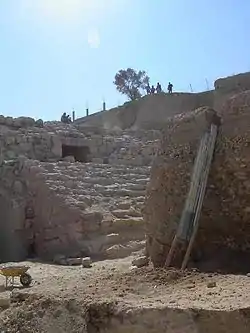Dium (Coele-Syria)
Dium or Dion (Ancient Greek: Δῖον)[1][2][3] or Dia (Δία)[4][5] was a city in ancient Coele-Syria mentioned by numerous ancient writers. According to Stephanus of Byzantium, the city was a foundation of Alexander the Great, and named after the city Dium in Macedon.[3] It was also wrongly called Pella by some ancient writers.[6]

Location
Dium is mostly identified with Tell el-Ash'ari from the Daraa Governorate in southwestern Syria[7][8] (see fr:Tell al-Achari at French Wikipedia). Some associate Dium with Aidoun south of Irbid. Some other have identified it falsely the later Capitolias, now Beit Ras in Jordan. in Jordan.[9]
The location of Dium is therefore not proven with certainty. According to Ptolemy, the city was positioned between Pella and Gadara which are both in Jordan,[2] and quite close to it;[10] but its latitude was quite uncertain.[2] Josephus in his retelling of Pompey's march through the area, says he came from Damascus via Dium to Pella,[11] thus putting Dium to the north of Pella.[9] The Ruins of Tell Ashari fulfill the concept of a small greek City positioned at a Mount and around it. A Theatre high above the yarmouk river ravine is unfortunately due to the civil war in a really bad condition. At this time now, all facts speek for Tell Ashari as Dion of the Decapolis.
As a small Remark is to notice that beside of the probably military fortress city of Raphana all other Decapolis Cities ( also some others before unmentioned but positioned within the Decapolis region) were after the second century A.D. also episcopal Sees.
But Dion ( not to confuse with Dionysias/ As Suweida) , who was normally inside the protected territories of these days, was not a episcopal see, why?
Historical sources
Stephanus notes that the city's water was unhealthy. Little is known about the history of the city. Like most of the Hellenistic cities in that region, it was subjugated to the Jews under Alexander Jannaeus, who conquered the town,[4] which was then conquered by Pompey and its freedom restored in 62 BCE.[11] The coins of Dium are from the Pompeian era. Pliny the Elder and Ptolemy count the city as among the Decapolis.[1][2]
References
- Pliny. Naturalis Historia. Vol. 5.74.
- Ptolemy. The Geography. Vol. 5.15, 23.
- Stephanus of Byzantium. Ethnica. Vol. s.v.
- Josephus, Ant. Iud., 13.393
- Hierocles. Synecdemus. Vol. 722.
- Stephanus of Byzantium, Ethnica, § D232.3
- Schürer, Emil (2014). The History of the Jewish People in the Age of Jesus Christ (175 B.C.-A.D. 135). Vol. 2 (revised by Geza Vermes, Fergus Millar, Matthew Black ed.). Bloomsbury T&T Clark. pp. 148–149. ISBN 978-0-5672-9891-1. Retrieved 12 December 2019.
- Negev, Avraham; Gibson, Shimon (2001). "Dium; Dion". Archaeological Encyclopedia of the Holy Land. New York: Continuum. p. 142. ISBN 0-8264-1316-1.
- Ahmad Abdel-Haleem Al-Malabeh; Stephan Kempe; Shaher Rababa (2008). "The Decapolis Aqueduct Tunnel System (Al-Tura – Umm Quis, Jordan): The Longest in Antique History". Retrieved 16 December 2019.
Dion (Adun, Ancient Capitolias)
- Immanuel Benzinger: Δῖον 5.(in German) In: Realencyclopädie der classischen Altertumswissenschaft (RE). Vol. V,1, Stuttgart 1903, col. 833 f.
- Josephus, Ant. Iud. 14.74 et seq.